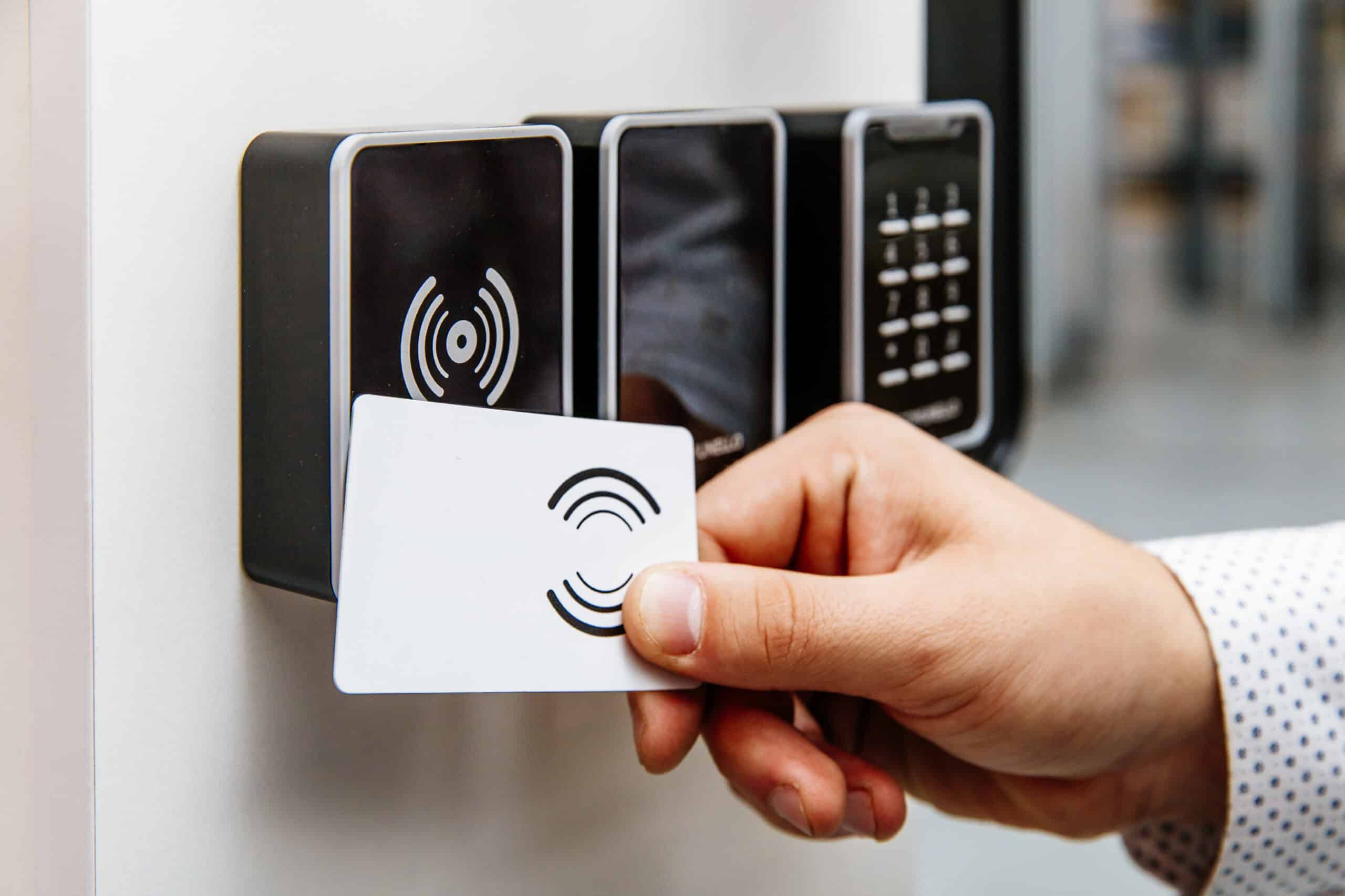Security is no longer optional—it’s essential. Businesses, government facilities, and even residential communities require top-tier security solutions to protect assets, personnel, and sensitive information. That’s where card access control systems step in as game-changers.
By integrating smart technology, these systems offer an advanced, convenient, and highly secure way to regulate entry to buildings, data centers, and restricted zones. Whether it’s ID card access control systems or swipe card door access control systems, these solutions minimize unauthorized access and enhance security.
At R3 Access Inc., we specialize in cutting-edge security solutions, from wireless access control to biometric access systems and smart home security solutions. Let’s explore how card access control systems can transform security measures for businesses and individuals alike.
What is a Card Access Control System?
A card access control system is an electronic security solution that uses ID cards, smart cards, or key fobs to grant or restrict access to specific areas. These systems replace traditional lock-and-key mechanisms, offering enhanced security, convenience, and control.
With a smart card access control system, users simply tap or swipe their credentials against a reader to unlock doors, turnstiles, or entry gates. The system then verifies credentials against a database, granting access only to authorized personnel.
Some common types of access control systems include Key Card Entry Systems, Swipe Card Door Access Control Systems, and Proximity Card Access Systems, each offering different levels of security and convenience:
- Key Card Entry System – A security system using programmed key cards for access control, ensuring only authorized individuals can enter specific areas while maintaining safety and convenience.
- Swipe Card Door Access Control Systems – Users must swipe a magnetic-stripe card through a reader to gain entry, providing secure, controlled access while tracking entry attempts efficiently.
- Proximity Card Access System – Utilizing RFID or NFC technology, this system enables contactless entry, allowing users to access secured areas simply by holding their card near the reader.
Related Article: Innovative Uses of Card Readers in Various Industries
How Do Card Access Control Systems Work?
The functionality of card access control systems involves a combination of hardware and software:
- Credential System – Users receive unique access cards or fobs, ensuring secure entry by verifying identity before granting access to restricted areas in a controlled environment.
- Card Reader – A device that scans, detects, and verifies encoded data from an access card or fob, determining whether to grant or deny entry based on credentials.
- Access Control Panel – Processes access requests by checking user credentials against stored data, determining authorization status, and communicating with electronic locks for security enforcement.
- Electronic Lock Mechanism – Once access is approved, the system signals the lock to disengage, allowing authorized users entry while preventing unauthorized access attempts effectively.
- Audit Logs & Monitoring – Tracks and records all entry attempts in real-time, enabling administrators to monitor access activities, detect anomalies, and enhance security oversight efficiently.
These systems integrate with cloud-based access solutions, enabling remote access control, real-time monitoring, and seamless management for enhanced security and convenience.
Related Article: How Card Readers Enhance Your Security and Efficiency
The Benefits of Card Access Control Systems

Enhanced Security & Restricted Access
ID card access control systems replace traditional keys, preventing unauthorized duplication. Only users with valid credentials can access secured areas, ensuring better security.
Remote Monitoring & Cloud Integration
Cloud-based access solutions allow administrators to manage permissions, receive security alerts, and monitor real-time entry logs from any location for enhanced security control.
Scalability & Customization
These systems accommodate small businesses to large enterprises, offering flexible access control solutions that adapt to organizational growth and evolving security requirements.
Improved Employee & Visitor Management
Companies can regulate employee access levels, issue temporary visitor passes, and maintain detailed security logs for audits, compliance, and operational efficiency.
Integration with Other Security Systems
Advanced access control solutions seamlessly work with biometric scanners, CCTV surveillance, automated gates, and perimeter security systems to create a comprehensive security infrastructure.
Related Article: Wall-Mounted Card Readers vs Stand-Alone Card Readers: What’s Best for You?
What Are the Three Types of Access Control?
Security experts categorize access control systems into three main types:
1. Discretionary Access Control (DAC)
Owners or administrators assign access rights, allowing flexible security management. Commonly implemented in office buildings and commercial security systems for controlled access.
2. Mandatory Access Control (MAC)
A rigid security model is used in government facilities, where users receive predefined access permissions based on security clearance, ensuring strict access regulations.
3. Role-Based Access Control (RBAC)
Access permissions are determined by an individual’s role within an organization, making it ideal for industrial security, corporate environments, and healthcare facilities.
How to Install a Card Access Control System
Installing a card access control system requires careful planning and execution.
Step 1: Site Assessment & Planning
Evaluate security risks, identify entry points, and define access levels to ensure only authorized individuals gain entry, enhancing overall protection and preventing unauthorized access effectively.
Step 2: Choosing the Right System
Assess security requirements to determine if a swipe card, smart card, or biometric access system provides the best balance of convenience, control, and protection.
Step 3: Installing Card Readers & Panels
- Position card readers at main entry points to control access, enhance security, and ensure only authorized individuals can enter restricted areas while preventing unauthorized entry attempts effectively.
- Set up access control panels for centralized management to monitor access logs, manage permissions, and streamline security operations, ensuring efficient control over all entry points in real time.
Step 4: Software Configuration & User Enrollment
- Register authorized users and assign access levels to ensure only approved individuals gain entry, enhancing security by defining specific permissions based on roles and responsibilities.
- Integrate with wireless access control or cloud-based access solutions to enable remote management, real-time monitoring, and seamless scalability for enhanced security and operational efficiency.
Step 5: Testing & Security Optimization
- Conduct system testing for accuracy and responsiveness to ensure access control functions properly detect credentials correctly and prevent unauthorized entry through rigorous performance evaluations.
- Optimize security settings and enable audit logging to enhance protection, track entry attempts, and maintain detailed access records for compliance, monitoring, and incident investigations.
R3 Access Inc. provides expert installation and maintenance of access control systems, delivering reliable security solutions for businesses and homes with seamless protection and support.
Related Article: High-Quality Card Readers Key Features
What Are the Different Types of Access Control Cards?
1. Proximity Cards (RFID/NFC)
- Utilize contactless access cards with radio frequency technology to enable seamless, secure entry by allowing users to gain access without physical contact, enhancing convenience and security.
2. Magnetic Stripe Cards
- Require swiping through a reader in older swipe card systems to verify credentials, granting access only when the magnetic stripe is properly read, ensuring controlled entry.
3. Smart Cards
- Embedded with microchips for advanced encryption and security to protect sensitive data, enhance authentication, and prevent unauthorized duplication or tampering for improved access control.
4. Biometric Access Cards
- Store fingerprint or retina scan data for ultra-secure access to ensure highly accurate identity verification, preventing unauthorized entry and enhancing overall security measures.
Each option plays a vital role in commercial security and residential access control, ensuring authorized access, enhancing safety, and preventing unauthorized entry effectively.
Related Article: The Best Security Systems for Home in 2024
Why Choose R3 Access Inc. for Your Access Control Needs?
At R3 Access Inc., we specialize in delivering top-tier security solutions tailored to various industries. Our services include:
- Card Reader Access Control & Keypad Entry Systems
- High-Security Gate Operators & Automated Gate Operators
- Perimeter Security Solutions & Anti-Ram Barriers
- Smart Home Security Solutions & Traffic Control Devices
We offer comprehensive end-to-end solutions covering system design, professional installation, and 24/7 technical support to ensure seamless operation and reliable security management.
Final Thoughts:
Security is not just about keeping threats out—it’s about ensuring efficient, controlled access. Card access control systems help businesses, government facilities, and residential communities enhance security by restricting unauthorized entry, tracking access logs, and integrating with advanced technologies for seamless, reliable, and scalable security management solutions.
If you’re searching for cloud-based access solutions, wireless access control, or smart home security, R3 Access Inc. has you covered. We provide cutting-edge card access control systems to protect businesses and homes. Contact us today at R3AccessInc.com to enhance security and ensure seamless, controlled access to your property.
FAQs
What are Card Access Control Systems?
Card Access Control Systems manage and restrict entry to secured areas using authentication methods like keycards, biometrics, PIN codes, or mobile credentials for enhanced security.
What is a Card Access Control System?
A security solution utilizing keycards or smart cards to regulate entry, ensuring only authorized individuals can access specific areas based on predefined permissions.
What are the different types of Card Access Control Systems?
Common types of Card Access Control Systems include proximity cards, smart cards, magnetic stripe cards, and biometric access cards, each offering varying levels of security and authentication.
What are the three types of Card Access Control Systems?
The primary types of Card Access Control Systems are Discretionary Access Control (DAC), Mandatory Access Control (MAC), and Role-Based Access Control (RBAC), each defining access based on different security policies.
How do swipe Card Access Control Systems work?
Users swipe a magnetic-stripe card through a reader, which verifies credentials and grants or denies access based on pre-configured security settings.


